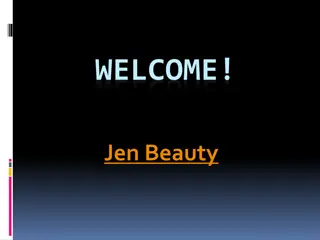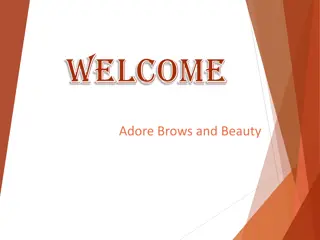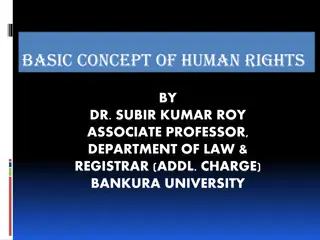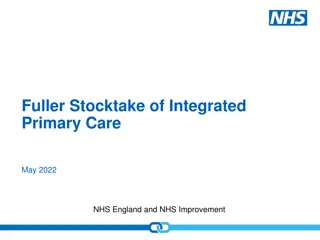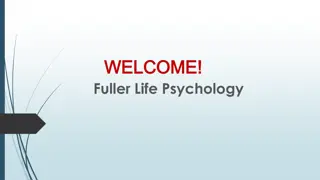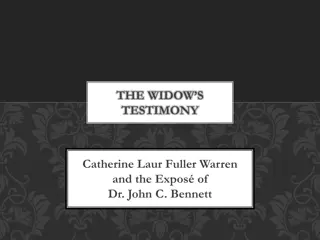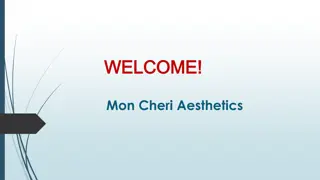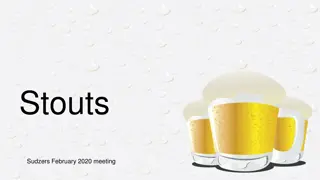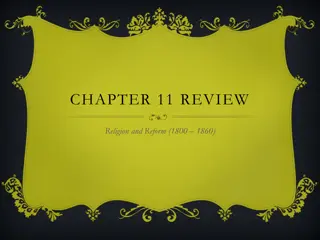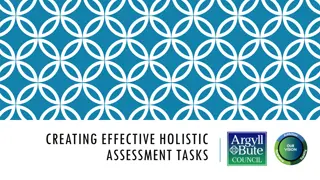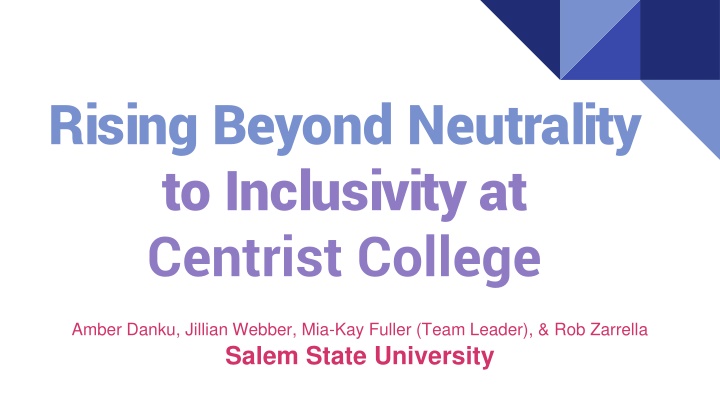
Moving Towards Gender Inclusivity at Centrist College
Explore strategies for promoting gender inclusivity at Centrist College through a professional development series addressing transgender issues, gender expression, and identity. Learn about the Gender Spectrum, student development theories, and ways to create a more inclusive campus for the Trans community. Quiz your knowledge on gender concepts and understanding outside the gender binary.
Download Presentation

Please find below an Image/Link to download the presentation.
The content on the website is provided AS IS for your information and personal use only. It may not be sold, licensed, or shared on other websites without obtaining consent from the author. If you encounter any issues during the download, it is possible that the publisher has removed the file from their server.
You are allowed to download the files provided on this website for personal or commercial use, subject to the condition that they are used lawfully. All files are the property of their respective owners.
The content on the website is provided AS IS for your information and personal use only. It may not be sold, licensed, or shared on other websites without obtaining consent from the author.
E N D
Presentation Transcript
Rising Beyond Neutrality to Inclusivity at Centrist College Amber Danku, Jillian Webber, Mia-Kay Fuller (Team Leader), & Rob Zarrella Salem State University
Questions this Professional Development Series Addresses: What do you know about Transgender ? Gender: A binary or is it? How does gender expression and identity impact students here? Who are Trans students and what do they want us to know? What Student Development Theories should we brush up on? What does Centrist College do well? What can Centrist College do better? How can we commit ourselves to actively changing our campus to be more inclusive to the Trans community?
Learning Outcomes: As a result of this professional development series, senior staff will be able to: Know the definitions of binary, gender, and transgender List (3) ways that Centrist College can change now to be more inclusive of transgender students Create a list of (5) goals that senior staff would ideally like Centrist College to meet before 2019 Understand the (3) ways the Commitment Statement can be used
Quiz Time Can you match a words from the word bank with the following definitions? A. Describes someone who is comfortable with the gender identity & gender expression assigned to them based on their physical sex B. Either the male or the female division of species differentiated by social and cultural roles and behavior C. Something that is made of two pieces or parts D. A person s sense of being masculine, feminine or other gendered E. A person who lives as a member of a gender other than that expected of them based on anatomical sex F. The irrational fear of those who are gender variant and/or the inability to deal with a gender ambiguity
Gender: A Binary or is it? Gender Binary Rules of Thumb: Must identify as either Male or Female Only two gender options Societal Institutions reinforce this binary (e.g. education, government, consumerism) Non-Gender Binary Rules of Thumb: Can identify within the gender spectrum Multiple gender options Supported through policies and deconstruction of gendered institutions (e.g., gender inclusive restrooms, gender inclusive housing, gender neutral language) The Gender Spectrum *Not just Male or Female (image from csrspreadscience.files.wordpress.com/2015/03/gender.jpg)
Do you know someone who identifies outside of the gender binary? Do you know someone who is trans*? How does this impact the students at Centrist? Click on image to go to Prezi (Clifford, 2015)
Who are trans* students? Transgender students may be of any age, ethnicity, race, class, or sexual orientation. Some enter higher education open about being transgender, while others come out during college or graduate school. Still others may never use the term transgender, but will strongly identify themselves as male, female, transsexual, or another (or no) gender. Some students may choose to transition; that is, to live as a gender different from the one assigned to them at birth. (Beemyn et al., 2005, p. 50)
Where are our students at? In 2014, the U.S. Education Department issued guidance that made clear that transgender students are protected from discrimination by the federal civil-rights law Title IX regardless of discrimination policies at institutions (Gardner, 2015) this includes housing! As there are no documentation measures in place,we cannot support our trans students properly (e.g., housing, counseling, medical care) Lack of gender inclusive restrooms so students are forced to choose an identity Lack of gender inclusive athletic facilities for trans* athletes Registration and personal-data collection systems do not typically use gender inclusive language (chosen names and pronouns included) No System for Inclusion in place Gender identity is not included in nondiscrimination or inclusion policies at institutions Gender inclusive housing is either non existent or inclusive to certain extents (e.g., apartments gender inclusive but rooms still assigned by biological sex) Facing constant misgendering through societal assumptions Feeling a general lack of awareness of their lives from faculty, staff, and admin (The Chronicle of Higher Education, 2015)
What LGBTQIA+ Students Want Their Professors to Know Click on image to go to video (Schmalz, 2015)
Student Development Theory to know: Gender + Gender Identity Development: Gender Binary Construct Male or Female Bem s Sex-Role Inventory Masculinity, Femininity, Androgyny Transgender Identity Development Arlene Istar Lev s, Transgender Emergence Model (to the left) (Safe Zone, n.d.)
Centrist College-background & pop. 47% male 49% female 4% Unidentified Mid-size institution (8-9k) Demographics: No demographics about non-binary students or sexual orientation 83% white 12% PoC 5% Unidentified LGBTQ+ resources limited to what state mandates Basic safezone training Multicultural Center
What is Centrist doing well? Serving Trans students on campus who are *openly* identified Knowing where these students can go on campus to receive counseling when needed Incorporating some educational training to staff on the Trans* community, usually within LGBTQA+ programming Tolerance Offering initial and ongoing support for the Trans* community with the Diversity Office and Health Services We have the basics down, but more is needed to continue our journey of becoming a more inclusive institution.
Example of an Institutions Change of Gender form Changes we can make now Preferred name policy Change of Name forms Will impact all students, not just transgender students. Change of Gender form availability (e.g. left) Gender neutral bathrooms (designated by signs) Inclusive housing options https://upload.wikimedia.org/wikipedia/commons/c/c3/Whitehead-link-alternative-sexuality-symbol.svg (Request to Change Gender in MainStreet Database. n.d.)
Long term changes to becoming more inclusive Medical needs covered under institutional insurance (hormones, surgery) Inclusive athletics policies (no gender based discrimination) Inclusive admission policies (language used/vocab terms, definitions) Creation & implementation of an LGBTQ resource center (Admission of Transgender Students, 2014)
Action Plan-3 year Strategic Plan outlining changes to be more inclusive with Transgender folks From 2016 to 2019, Centrist College will see a more inclusive campus between both academic and student life on campus. We will do this through a series of attainable and realistic goals. Please work together and brainstorm a list of goals you d (individually, office-wide, institutionally) like to meet by 2019 Adapted from Emory University s Strategic Plan
Action Plan: Year 1-Information Collection Develop institutional needs-assessments and focus groups in order to gather a pulse on the current campus climate of the Trans* community. These will allow Centrist College to better understand the size of the Trans* community and their needs. Adapted from Emory University s Strategic Plan
Action Plan: Year 2 -Implementation Upon Evidence After a year of collecting valuable information on the Trans* community and its needs, Centrist College will use that information to establish new programs/services and further develop existing programs/services. For example, there is a Trans* community at Centrist College. With the information that we gathered, creating an LGBT center in order to serve student needs and support students will be vital. Adapted from Emory University s Strategic Plan
Action Plan: Year 3 -Assessment of Implementation In order to ensure that the programs and services that we ve implemented are effective and frequented, we must conduct another assessment. A great question to ask in our assessment is: Are we meeting the needs of the Trans* community? If our programs and/or services could be changed to better suit the needs of the Trans* community, we must be receptive and adaptive to those changes Adapted from Emory University s Strategic Plan
Statement of Commitment to the Centrist College Trans* Community We have drafted a statement, which we believe all administrators and staff should commit to in order to benefit the Trans* community on campus, and create accountability. As leaders in higher education at Centrist College, we have the responsibility to commit ourselves to better serving the population of Trans* persons within our community through improving our offices, services, resources and campus environments. This includes first educating ourselves and others in recognizing the unique and current issues that persons who identify as Trans* may face, and a knowledge on intersectionality. We will ensure Trans* voices are heard and visible on Centrist s campus through intentional programming and respectful dialogue. Our responsibility includes speaking out and acting with a zero tolerance policy against prejudice, harassment, and violence. Through this commitment, we hope to make our campus a welcoming space for everyone, which allows our community to thrive and foster a sense of pride in individuality, equality, trust, and acceptance for Trans* identifying students, faculty, and staff . (Mission, vision, and values, n.d., Mission, Vision & Values, n.d., Mission Statement -Gay, Lesbian, Bisexual, Transgender, Queer, Questioning, and Ally Resource Center, n.d.)
How to use this commitment statement: Introduce this statement to those within your department and your supervisees by placing it on your door, hanging it in your office, or placing it in a prominent place that makes sense for you and your department. Incorporate this statement as a starting point for employee training, professional development, and conversations on inclusion. Use or revise the following sample wording for introduction emails or in-person meetings or trainings: We are models of the commitment to our trans* students development and experience at Centrist College. We are also modeling a commitment to the values and basic standards determined by the Council for the Advancement of Standards within the profession of higher education regarding promoting commonalities and differences, respecting sexual orientation, gender identity, and expression, and fostering a welcoming and inclusive environment.This statement of our commitment is important to the entire campus community thatwe serve. From here, another suggestion would be to give each employee a physical copy of the statement for their own use, and sign it using their preferred name and pronouns. This is just the starting point. (CAS Standards, 2014)
Future of Centrist College --What 2019 might look like Goals by 2019 including: Increased awareness of needs of Trans* community Throught the implementation of LGBTQ+ Resource Center Student, Faculty and Staff acceptance of Trans* community A more welcomed and comfortable Trans* student body Welcoming Admissions & Athletics policies Gender Neutral housing & bathrooms Greater retention and graduation rates Generally more diverse campus community
Question? Concerns? Qualms? Queries? Inquisitions? Ask now, or come find us later!
References Admission of Transgender Students. (2014). Retrieved February 22, 2016, from https://www.mtholyoke.edu/policies/admission-transgender-students Beemyn, B., Curtis, B., Davis, M., & Tubbs, N. J. (2005). Transgender issues on college campuses. New Directions for Student Services, 2005(111), 49-60. Retrieved from http://vp.studentlife.uiowa.edu/assets/Transgender-Issues-on-College-Campuses.pdf Clifford, A. (2015). Gender Identity & Expression Map [Prezi Presentation]. Retrieved from https://prezi.com/yvqu4hrcexig/gender-identity-expression-map/. Emory University. (2012). Office of lesbian, gay, bisexual, and transgender life strategic plan. Retrieved February 25, 2016,from http://www.lgbt.emory.edu/docs/strategic_plan.pdf Gardner, L. (2015, October 18). Dilemmas from day 1. Retrieved February 25, 2016, from http://chronicle.com/article/Dilemmas-From-Day-1/233760?cid=cp11 Mission Statement - Gay, Lesbian, Bisexual, Transgender, Queer, Questioning, and Ally Resource Center. (n.d.). Retrieved February 15, 2016, from http://www.glbtrc.colostate.edu/mission-statement Mission, Vision & Values (n.d.). Retrieved February 15, 2016, from https://www.campuspride.org/about/mission/ Mission, vision, and values. (n.d.). Retrieved February 15th, 2016, from http://transgenderlawcenter.org/about/mission Park, P. (2013, April).Transgendering the Academy: Ensuring Transgender Inclusion in Higher Education. Symposium conducted at the Spring Colloquium Of the Institute for Research on Women s Trans Politics: Scholarship and Strategies for Social Change, Rutgers University, New Brunswick, NJ. Request to Change Gender in MainStreet Database. (n.d.). Retrieved February 22, 2016, from https://machias.edu/assets/files/academics/Registrar_s Office/Gender_Change_Form.pdf Standards. (n.d.). Retrieved February 15, 2016, from http://www.cas.edu/index.php/standards/ Safe Zone. (n.d.). Retrieved February 22, 2016, from https://safezone.uncc.edu/allies/theories#Arlene_Istar_Lev Schmalz, J. (2015, September 03). 'Ask me': What LGBTQ students want their professors to know. Retrieved February 25, 2016, from http://chronicle.com/article/Ask-Me-What-LGBTQ-Students/232797

